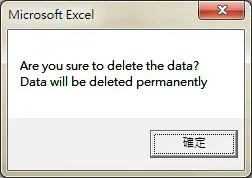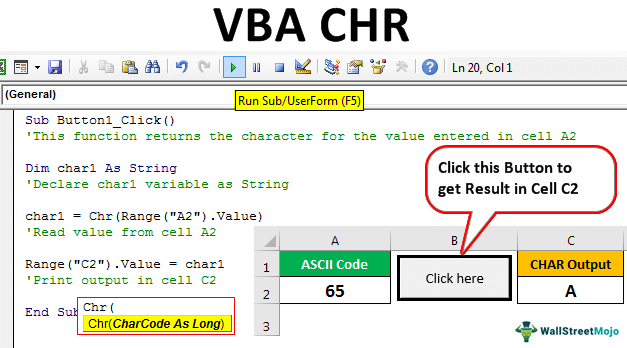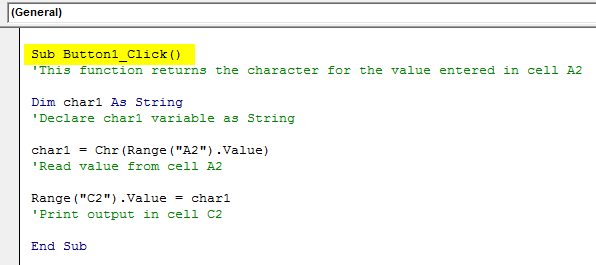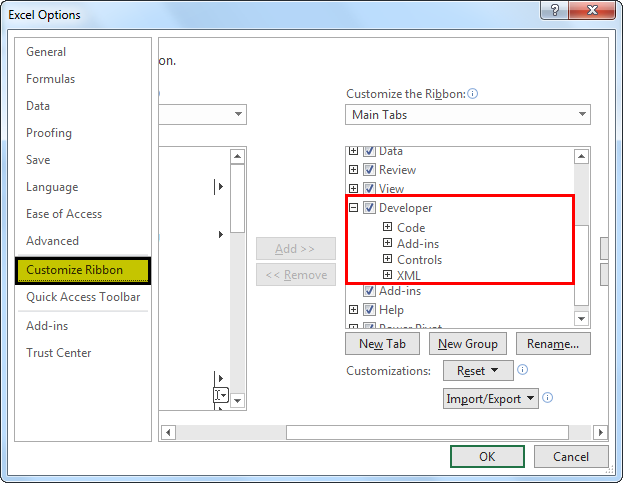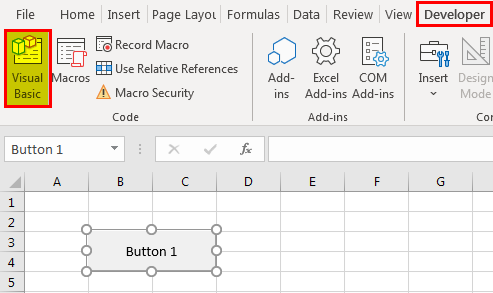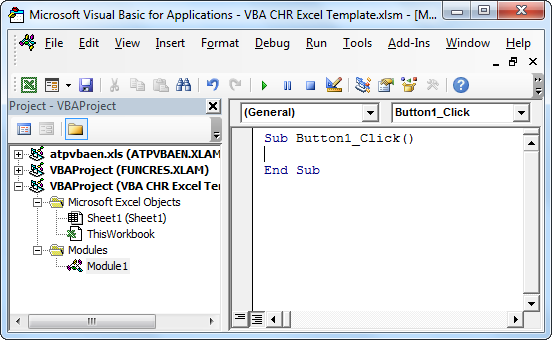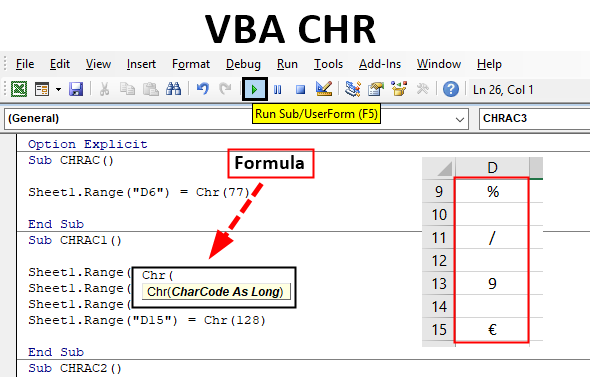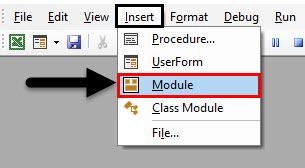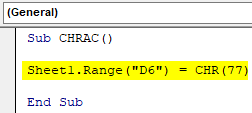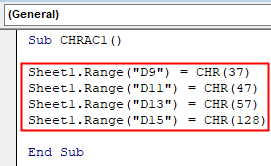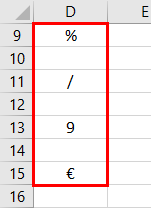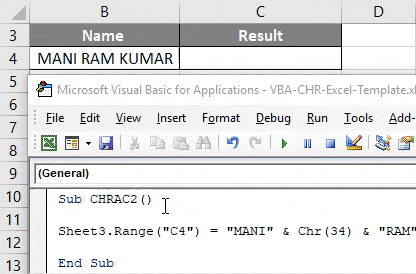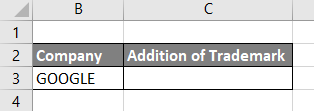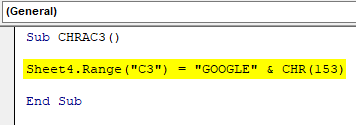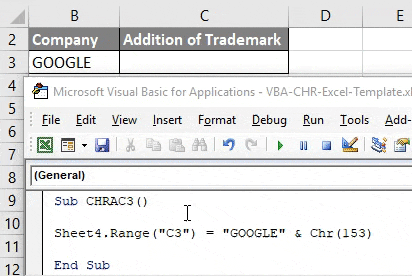This Access Excel VBA tutorial explains how to use Chr Function to convert ASCII value to character, and convert from character to ASCII value with ASC Function
What is Access Excel VBA Chr Function?
Access Excel VBA Chr Function converts ASCII value to a character. ASCII (American Standard Code for Information Interchange) uses 8-bit code units, an old encoding system which stores mainly numbers, lowercase letters a to z, uppercase letters A to Z, basic punctuation symbols, control codes. Many old systems still use this encoding system. 8 bit means the computer memory uses “8” digits with 1 and 0 combination (binary) to represent a character, 8 bits memory is equal to 1 byte.
Chr Function is applicable to: Excel VBA, Access, Access VBA
Refer to the below table, Excel Char Function will convert the “Dec” value to “Char” value.
| Dec | Hex | Oct | Char | Description |
|---|---|---|---|---|
| 0 | 0 | 000 | null | |
| 1 | 1 | 001 | start of heading | |
| 2 | 2 | 002 | start of text | |
| 3 | 3 | 003 | end of text | |
| 4 | 4 | 004 | end of transmission | |
| 5 | 5 | 005 | enquiry | |
| 6 | 6 | 006 | acknowledge | |
| 7 | 7 | 007 | bell | |
| 8 | 8 | 010 | backspace | |
| 9 | 9 | 011 | horizontal tab | |
| 10 | A | 012 | new line | |
| 11 | B | 013 | vertical tab | |
| 12 | C | 014 | new page | |
| 13 | D | 015 | carriage return | |
| 14 | E | 016 | shift out | |
| 15 | F | 017 | shift in | |
| 16 | 10 | 020 | data link escape | |
| 17 | 11 | 021 | device control 1 | |
| 18 | 12 | 022 | device control 2 | |
| 19 | 13 | 023 | device control 3 | |
| 20 | 14 | 024 | device control 4 | |
| 21 | 15 | 025 | negative acknowledge | |
| 22 | 16 | 026 | synchronous idle | |
| 23 | 17 | 027 | end of trans. block | |
| 24 | 18 | 030 | cancel | |
| 25 | 19 | 031 | end of medium | |
| 26 | 1A | 032 | substitute | |
| 27 | 1B | 033 | escape | |
| 28 | 1C | 034 | file separator | |
| 29 | 1D | 035 | group separator | |
| 30 | 1E | 036 | record separator | |
| 31 | 1F | 037 | unit separator | |
| 32 | 20 | 040 | space | |
| 33 | 21 | 041 | ! | |
| 34 | 22 | 042 | “ | |
| 35 | 23 | 043 | # | |
| 36 | 24 | 044 | $ | |
| 37 | 25 | 045 | % | |
| 38 | 26 | 046 | & | |
| 39 | 27 | 047 | ‘ | |
| 40 | 28 | 050 | ( | |
| 41 | 29 | 051 | ) | |
| 42 | 2A | 052 | * | |
| 43 | 2B | 053 | + | |
| 44 | 2C | 054 | , | |
| 45 | 2D | 055 | – | |
| 46 | 2E | 056 | . | |
| 47 | 2F | 057 | / | |
| 48 | 30 | 060 | 0 | |
| 49 | 31 | 061 | 1 | |
| 50 | 32 | 062 | 2 | |
| 51 | 33 | 063 | 3 | |
| 52 | 34 | 064 | 4 | |
| 53 | 35 | 065 | 5 | |
| 54 | 36 | 066 | 6 | |
| 55 | 37 | 067 | 7 | |
| 56 | 38 | 070 | 8 | |
| 57 | 39 | 071 | 9 | |
| 58 | 3A | 072 | : | |
| 59 | 3B | 073 | ; | |
| 60 | 3C | 074 | < | |
| 61 | 3D | 075 | = | |
| 62 | 3E | 076 | > | |
| 63 | 3F | 077 | ? | |
| 64 | 40 | 100 | @ | |
| 65 | 41 | 101 | A | |
| 66 | 42 | 102 | B | |
| 67 | 43 | 103 | C | |
| 68 | 44 | 104 | D | |
| 69 | 45 | 105 | E | |
| 70 | 46 | 106 | F | |
| 71 | 47 | 107 | G | |
| 72 | 48 | 110 | H | |
| 73 | 49 | 111 | I | |
| 74 | 4A | 112 | J | |
| 75 | 4B | 113 | K | |
| 76 | 4C | 114 | L | |
| 77 | 4D | 115 | M | |
| 78 | 4E | 116 | N | |
| 79 | 4F | 117 | O | |
| 80 | 50 | 120 | P | |
| 81 | 51 | 121 | Q | |
| 82 | 52 | 122 | R | |
| 83 | 53 | 123 | S | |
| 84 | 54 | 124 | T | |
| 85 | 55 | 125 | U | |
| 86 | 56 | 126 | V | |
| 87 | 57 | 127 | W | |
| 88 | 58 | 130 | X | |
| 89 | 59 | 131 | Y | |
| 90 | 5A | 132 | Z | |
| 91 | 5B | 133 | [ | |
| 92 | 5C | 134 | ||
| 93 | 5D | 135 | ] | |
| 94 | 5E | 136 | ^ | |
| 95 | 5F | 137 | _ | |
| 96 | 60 | 140 | ` | |
| 97 | 61 | 141 | a | |
| 98 | 62 | 142 | b | |
| 99 | 63 | 143 | c | |
| 100 | 64 | 144 | d | |
| 101 | 65 | 145 | e | |
| 102 | 66 | 146 | f | |
| 103 | 67 | 147 | g | |
| 104 | 68 | 150 | h | |
| 105 | 69 | 151 | i | |
| 106 | 6A | 152 | j | |
| 107 | 6B | 153 | k | |
| 108 | 6C | 154 | l | |
| 109 | 6D | 155 | m | |
| 110 | 6E | 156 | n | |
| 111 | 6F | 157 | o | |
| 112 | 70 | 160 | p | |
| 113 | 71 | 161 | q | |
| 114 | 72 | 162 | r | |
| 115 | 73 | 163 | s | |
| 116 | 74 | 164 | t | |
| 117 | 75 | 165 | u | |
| 118 | 76 | 166 | v | |
| 119 | 77 | 167 | w | |
| 120 | 78 | 170 | x | |
| 121 | 79 | 171 | y | |
| 122 | 7A | 172 | z | |
| 123 | 7B | 173 | { | |
| 124 | 7C | 174 | | | |
| 125 | 7D | 175 | } | |
| 126 | 7E | 176 | ~ | |
| 127 | 7F | 177 | DEL |
Extended Character Set
| Dec | Hex | Unicode |
Char |
Name |
|---|---|---|---|---|
| 128 | 80 | U+20AC | € | Euro Sign |
| 129 | 81 | Undefined | ||
| 130 | 82 | U+201A | ‚ | Single Low-9 Quotation Mark |
| 131 | 83 | U+0192 | ƒ | Latin Small Letter F With Hook |
| 132 | 84 | U+201E | „ | Double Low-9 Quotation Mark |
| 133 | 85 | U+2026 | … | Horizontal Ellipsis |
| 134 | 86 | U+2020 | † | Dagger |
| 135 | 87 | U+2021 | ‡ | Double Dagger |
| 136 | 88 | U+02C6 | ˆ | Modifier Letter Circumflex Accent |
| 137 | 89 | U+2030 | ‰ | Per Mille Sign |
| 138 | 8A | U+0160 | Š | Latin Capital Letter S With Caron |
| 139 | 8B | U+2039 | ‹ | Single Left-pointing Angle Quotation Mark |
| 140 | 8C | U+0152 | Π| Latin Capital Ligature Oe |
| 141 | 8D | Undefined | ||
| 142 | 8E | U+017D | Ž | Latin Capital Letter Z With Caron |
| 143 | 8F | Undefined | ||
| 144 | 90 | Undefined | ||
| 145 | 91 | U+2018 | ‘ | Left Single Quotation Mark |
| 146 | 92 | U+2019 | ’ | Right Single Quotation Mark |
| 147 | 93 | U+201C | “ | Left Double Quotation Mark |
| 148 | 94 | U+201D | ” | Right Double Quotation Mark |
| 149 | 95 | U+2022 | • | Bullet |
| 150 | 96 | U+2013 | – | En Dash |
| 151 | 97 | U+2014 | — | Em Dash |
| 152 | 98 | U+02DC | ˜ | Small Tilde |
| 153 | 99 | U+2122 | ™ | Trade Mark Sign |
| 154 | 9A | U+0161 | š | Latin Small Letter S With Caron |
| 155 | 9B | U+203A | › | Single Right-pointing Angle Quotation Mark |
| 156 | 9C | U+0153 | œ | Latin Small Ligature Oe |
| 157 | 9D | Undefined | ||
| 158 | 9E | U+017E | ž | Latin Small Letter Z With Caron |
| 159 | 9F | U+0178 | Ÿ | Latin Capital Letter Y With Diaeresis |
| 160 | A0 | U+00A0 | No-break Space | |
| 161 | A1 | U+00A1 | ¡ | Inverted Exclamation Mark |
| 162 | A2 | U+00A2 | ¢ | Cent Sign |
| 163 | A3 | U+00A3 | £ | Pound Sign |
| 164 | A4 | U+00A4 | ¤ | Currency Sign |
| 165 | A5 | U+00A5 | ¥ | Yen Sign |
| 166 | A6 | U+00A6 | ¦ | Broken Bar |
| 167 | A7 | U+00A7 | § | Section Sign |
| 168 | A8 | U+00A8 | ¨ | Diaeresis |
| 169 | A9 | U+00A9 | © | Copyright Sign |
| 170 | AA | U+00AA | ª | Feminine Ordinal Indicator |
| 171 | AB | U+00AB | « | Left-pointing Double Angle Quotation Mark |
| 172 | AC | U+00AC | ¬ | Not Sign |
| 173 | AD | U+00AD | | Soft Hyphen |
| 174 | AE | U+00AE | ® | Registered Sign |
| 175 | AF | U+00AF | ¯ | Macron |
| 176 | B0 | U+00B0 | ° | Degree Sign |
| 177 | B1 | U+00B1 | ± | Plus-minus Sign |
| 178 | B2 | U+00B2 | ² | Superscript Two |
| 179 | B3 | U+00B3 | ³ | Superscript Three |
| 180 | B4 | U+00B4 | ´ | Acute Accent |
| 181 | B5 | U+00B5 | µ | Micro Sign |
| 182 | B6 | U+00B6 | ¶ | Pilcrow Sign |
| 183 | B7 | U+00B7 | · | Middle Dot |
| 184 | B8 | U+00B8 | ¸ | Cedilla |
| 185 | B9 | U+00B9 | ¹ | Superscript One |
| 186 | BA | U+00BA | º | Masculine Ordinal Indicator |
| 187 | BB | U+00BB | » | Right-pointing Double Angle Quotation Mark |
| 188 | BC | U+00BC | ¼ | Vulgar Fraction One Quarter |
| 189 | BD | U+00BD | ½ | Vulgar Fraction One Half |
| 190 | BE | U+00BE | ¾ | Vulgar Fraction Three Quarters |
| 191 | BF | U+00BF | ¿ | Inverted Question Mark |
| 192 | C0 | U+00C0 | À | Latin Capital Letter A With Grave |
| 193 | C1 | U+00C1 | Á | Latin Capital Letter A With Acute |
| 194 | C2 | U+00C2 | Â | Latin Capital Letter A With Circumflex |
| 195 | C3 | U+00C3 | Ã | Latin Capital Letter A With Tilde |
| 196 | C4 | U+00C4 | Ä | Latin Capital Letter A With Diaeresis |
| 197 | C5 | U+00C5 | Å | Latin Capital Letter A With Ring Above |
| 198 | C6 | U+00C6 | Æ | Latin Capital Ligature Ae |
| 199 | C7 | U+00C7 | Ç | Latin Capital Letter C With Cedilla |
| 200 | C8 | U+00C8 | È | Latin Capital Letter E With Grave |
| 201 | C9 | U+00C9 | É | Latin Capital Letter E With Acute |
| 202 | CA | U+00CA | Ê | Latin Capital Letter E With Circumflex |
| 203 | CB | U+00CB | Ë | Latin Capital Letter E With Diaeresis |
| 204 | CC | U+00CC | Ì | Latin Capital Letter I With Grave |
| 205 | CD | U+00CD | Í | Latin Capital Letter I With Acute |
| 206 | CE | U+00CE | Î | Latin Capital Letter I With Circumflex |
| 207 | CF | U+00CF | Ï | Latin Capital Letter I With Diaeresis |
| 208 | D0 | U+00D0 | Ð | Latin Capital Letter Eth |
| 209 | D1 | U+00D1 | Ñ | Latin Capital Letter N With Tilde |
| 210 | D2 | U+00D2 | Ò | Latin Capital Letter O With Grave |
| 211 | D3 | U+00D3 | Ó | Latin Capital Letter O With Acute |
| 212 | D4 | U+00D4 | Ô | Latin Capital Letter O With Circumflex |
| 213 | D5 | U+00D5 | Õ | Latin Capital Letter O With Tilde |
| 214 | D6 | U+00D6 | Ö | Latin Capital Letter O With Diaeresis |
| 215 | D7 | U+00D7 | × | Multiplication Sign |
| 216 | D8 | U+00D8 | Ø | Latin Capital Letter O With Stroke |
| 217 | D9 | U+00D9 | Ù | Latin Capital Letter U With Grave |
| 218 | DA | U+00DA | Ú | Latin Capital Letter U With Acute |
| 219 | DB | U+00DB | Û | Latin Capital Letter U With Circumflex |
| 220 | DC | U+00DC | Ü | Latin Capital Letter U With Diaeresis |
| 221 | DD | U+00DD | Ý | Latin Capital Letter Y With Acute |
| 222 | DE | U+00DE | Þ | Latin Capital Letter Thorn |
| 223 | DF | U+00DF | ß | Latin Small Letter Sharp S |
| 224 | E0 | U+00E0 | à | Latin Small Letter A With Grave |
| 225 | E1 | U+00E1 | á | Latin Small Letter A With Acute |
| 226 | E2 | U+00E2 | â | Latin Small Letter A With Circumflex |
| 227 | E3 | U+00E3 | ã | Latin Small Letter A With Tilde |
| 228 | E4 | U+00E4 | ä | Latin Small Letter A With Diaeresis |
| 229 | E5 | U+00E5 | å | Latin Small Letter A With Ring Above |
| 230 | E6 | U+00E6 | æ | Latin Small Ligature Ae |
| 231 | E7 | U+00E7 | ç | Latin Small Letter C With Cedilla |
| 232 | E8 | U+00E8 | è | Latin Small Letter E With Grave |
| 233 | E9 | U+00E9 | é | Latin Small Letter E With Acute |
| 234 | EA | U+00EA | ê | Latin Small Letter E With Circumflex |
| 235 | EB | U+00EB | ë | Latin Small Letter E With Diaeresis |
| 236 | EC | U+00EC | ì | Latin Small Letter I With Grave |
| 237 | ED | U+00ED | í | Latin Small Letter I With Acute |
| 238 | EE | U+00EE | î | Latin Small Letter I With Circumflex |
| 239 | EF | U+00EF | ï | Latin Small Letter I With Diaeresis |
| 240 | F0 | U+00F0 | ð | Latin Small Letter Eth |
| 241 | F1 | U+00F1 | ñ | Latin Small Letter N With Tilde |
| 242 | F2 | U+00F2 | ò | Latin Small Letter O With Grave |
| 243 | F3 | U+00F3 | ó | Latin Small Letter O With Acute |
| 244 | F4 | U+00F4 | ô | Latin Small Letter O With Circumflex |
| 245 | F5 | U+00F5 | õ | Latin Small Letter O With Tilde |
| 246 | F6 | U+00F6 | ö | Latin Small Letter O With Diaeresis |
| 247 | F7 | U+00F7 | ÷ | Division Sign |
| 248 | F8 | U+00F8 | ø | Latin Small Letter O With Stroke |
| 249 | F9 | U+00F9 | ù | Latin Small Letter U With Grave |
| 250 | FA | U+00FA | ú | Latin Small Letter U With Acute |
| 251 | FB | U+00FB | û | Latin Small Letter U With Circumflex |
| 252 | FC | U+00FC | ü | Latin Small Letter U With Diaeresis |
| 253 | FD | U+00FD | ý | Latin Small Letter Y With Acute |
| 254 | FE | U+00FE | þ | Latin Small Letter Thorn |
| 255 | FF | U+00FF | ÿ | Latin Small Letter Y With Diaeresis |
Why do you need Access Excel VBAChr Function?
1. To import special characters. However, Windows may not be able to show those characters.
2. Start a new line in a Cell with Char(10) in worksheet (must need to set Wrap Text first) and MsgBox message
Syntax of Access Excel VBA Chr Function
CHR( ascii_value )
ascii_value is the ASCII value used to retrieve the character.
Note that Chr Function also exists for worksheet but the name is Char. You can convert the character back into ASCII value using Code Function in worksheet / ASC Function in VBA
Example of Access Excel VBA Chr Function
| Formula | Result | Explanation |
| Chr(65) | A | |
| Chr(90) | Z | |
| Range(“A1”).Value = “line one” & Chr(10) & “line two” | line one line two |
Start a new line with Char(10) |
| Range(“A1”).Value = Replace(“line one,line two”, “,”, Chr(10)) | line one line two |
Replace comma with new line |
To start a new line in VBA MsgBox
Public Sub test1()
sInput = MsgBox("Are you sure to delete the data?" & Chr(10) & "Data will be deleted permanently")
End Sub
Outbound References
http://www.techonthenet.com/excel/formulas/char.php
VBA CHR function in Excel is categorized as a Text/String function in VBA. It is a built-in function in MS Office Excel VBA. This function returns the character of the given ASCII value (or Character Code). The ASCII value should be between 0 and 255. ASCII stands for American Standard Code for Information Interchange. It has one input parameter. The CHR function can be used in only VBA. We can’t use this function as a worksheet function. This function can be used in either procedure or function in a VBA editor window in Excel. We can use this VBA CHR function any number of times in any number of procedures or functions. In the following section we learn what is the syntax and parameters of the CHR function, where we can use this VBA CHR function and real-time examples.
Table of Contents
- Objective
- Syntax of VBA CHR Function
- Parameters or Arguments
- Where we can apply or use VBA CHR Function?
- Example 1: Display the ASCII character of ‘65’
- Example 2: Display the ASCII character of ‘97’
- Example 3: Display the ASCII character of ‘64‘
- Example 4: Display the ASCII character of ‘270‘
- ASCII Table Chart
- Instructions to Run VBA Macro Code
- Other Useful Resources
The syntax of the VBA CHR function is
Chr (CharCode)
The VBA Chr function returns a string for the given character code.
Parameters or Arguments
The CHR function has one input (integer) parameter or argument.
Where
CharCode: It is a required parameter. The ‘CharCode’ is the character code for which we want to display respective ASCII character.
Where we can apply or use VBA CHR Function?
We can use this VBA CHR function in MS Office 365, MS Excel 2016, MS Excel 2013, 2011, Excel 2010, Excel 2007, Excel 2003, Excel 2016 for Mac, Excel 2011 for Mac, Excel Online, Excel for iPhone, Excel for iPad, Excel for Android tablets and Excel for Android Mobiles.
Example 1: Display the ASCII character of ‘65’
Here is a simple example of the VBA CHR function. This below example macro takes ‘65’ as input and generates output of specified value ASCII character.
'Display the ASCII character of '65'
Sub VBA_CHR_Function_Ex1()
Dim sOutput As String, iInput_Val As Integer
iInput_Val = 65
sOutput = Chr(iInput_Val)
MsgBox "The ASCII character of '65' is :" & sOutput, vbInformation, "VBA CHR Function"
End Sub
Output: Here is the screen shot of first example output.
Example 2: Display the ASCII character of ’97’
Let us see another example of the VBA CHR function. This below example macro takes ‘97’ as input and generates output of specified value ASCII character.
'Display the ASCII character of '97'
Sub VBA_CHR_Function_Ex2()
Dim sOutput As String, iInput_Val As Integer
iInput_Val = 97
sOutput = Chr(iInput_Val)
MsgBox "The ASCII character of '97' is :" & sOutput, vbInformation, "VBA CHR Function"
End Sub
Output: Here is the screen shot of second example output.
Example 3: Display the ASCII character of ’64’
Here is a simple example of the VBA CHR function. This below example macro takes ‘64’ as input and generates output of specified value ASCII character.
'Display the ASCII character of '64'
Sub VBA_CHR_Function_Ex3()
Dim sOutput As String, iInput_Val As Integer
iInput_Val = 64
sOutput = Chr(iInput_Val)
MsgBox "The ASCII character of '64' is :" & sOutput, vbInformation, "VBA CHR Function"
End Sub
Output: Here is the screen shot of third example output.
Example 4: Display the ASCII character of ‘270’
Let us see another example of the VBA CHR function. This below example macro takes ‘270’ as input and generates an error. Because specified input could be between 0 and 255. Otherwise, it returns an error.
Error Description: Run Time Error – Invalid Procedure Call or Argument
'Display the ASCII character of '270'
Sub VBA_CHR_Function_Ex4()
Dim sOutput As String, iInput_Val As Integer
iInput_Val = 270
sOutput = Chr(iInput_Val)
MsgBox "The ASCII character of '270' is :" & sOutput, vbInformation, "VBA CHR Function"
End Sub
Output: Here is the screen shot of fourth example output.
ASCII Table Chart
Please click on below link to see ASCII Table Chart.
ASCII Table Chart
Instructions to Run VBA Macro Code or Procedure:
You can refer the following link for the step by step instructions.
Instructions to run VBA Macro Code
Other Useful Resources:
Click on the following links of the useful resources. These helps to learn and gain more knowledge.
VBA Tutorial VBA Functions List VBA Arrays in Excel Blog
VBA Editor Keyboard Shortcut Keys List VBA Interview Questions & Answers
Excel VBA CHR Function
VBA CHR is a built-in function that falls under the String/Text Functions category used to get the character equivalent to the ASCII code. For example, the equivalent Excel Workspace function of CHR is Application.WorksheetFunction.CHAR.
Table of contents
- Excel VBA CHR Function
- Example
- How to Create a Button in Excel?
- Things to Remember
- Recommended Articles
Given below is the Chr syntax.
This function has one argument. Where,
Charco de = This is a required parameter. It is the ASCII code for which an equivalent character is to be retrieved.
The function returns a string value denoting the character equivalent to the given ASCII code. ASCII is a subset of the Unicode character coding standard formed by 128 symbols in the character set, including uppercase, lowercase letters, numbers, special characters, control characters, and punctuation marks. In addition, every symbol in the character set has an equivalent Decimal value (0 to 127), a Hexadecimal value, and an Octal value.
Example
You can download this VBA CHR Excel Template here – VBA CHR Excel Template
Step 1: In the Excel sheet, add two header texts in cells A1 and C1, as shown in the figure below. Column A to enter the ASCII code and column C to print the corresponding character calculated using the CHR function.
Step 2: Follow the steps in the next section to create a Button in the Excel workbook (please scroll the article) and change its caption to “Click here.”
Step 3: Write the following code snippet in VBA. The code reads the value from cell A2, which is given as an input to function CHR. The result is retrieved in String char1 and then assigned to cell C2.
Code:
Sub Button1_Click() 'This function returns the character for the value entered in cell A2 Dim char1 As String 'Declare char1 variable as String char1 = Chr(Range("A2").Value) 'Read value from cell A2 Range("C2").Value = char1 'Print output in cell C2 End Sub
Step 4: Save the VBA Excel codeVBA code refers to a set of instructions written by the user in the Visual Basic Applications programming language on a Visual Basic Editor (VBE) to perform a specific task.read more and go back to the Excel workbook to enter the input value in cell A2, as shown below.
Enter 65 as an ASCII input for the corresponding character to be found in cell C2.
Step 5: Click the “Click here” button to print the result in cell C2.
Observe the result printed in cell C2. The code snippet we wrote in step 3 is responsible for reading the input from cell A2, running the Chr function on it, and printing the value in cell C2, as shown below.
Here, the input given is 65, and the output received is A. So, Chr (65) = A.
Step 6: Try changing the input in cell A2 and observe that you get the respective output in cell C2, as shown below.
E.g. CHR (37) = % and so on.
How to Create a Button in Excel?
As a VBA function, we can use it in excel macroA macro in excel is a series of instructions in the form of code that helps automate manual tasks, thereby saving time. Excel executes those instructions in a step-by-step manner on the given data. For example, it can be used to automate repetitive tasks such as summation, cell formatting, information copying, etc. thereby rapidly replacing repetitious operations with a few clicks.
read more code, entered through the Microsoft Visual Basic Editor integrated into MS Excel. Refer to the steps given below to know more.
Step 1: Turn on Developer Mode in ExcelEnabling the developer tab in excel can help the user perform various functions for VBA, Macros and Add-ins like importing and exporting XML, designing forms, etc. This tab is disabled by default on excel; thus, the user needs to enable it first from the options menu.read more
For any VBA functionVBA functions serve the primary purpose to carry out specific calculations and to return a value. Therefore, in VBA, we use syntax to specify the parameters and data type while defining the function. Such functions are called user-defined functions.read more to use in Excel, one must turn on the Developer Mode from File->Options Menu, as shown in the figure below.
Click on File – > Excel Options – >Customize Ribbon ->Developer -> OK
As a result, a new toolbar option named “Developer” will be added to the workbook, as shown in the picture below.
Step 2: Saving the workbook
Save the Excel Workbook as an “Excel Macro-Enabled Workbook.”
Step 3: Insert a form control in a workbookExcel Form Controls are objects which can be inserted at any place in the worksheet to work with data and handle the data as specified. These controls are compatible with excel and can create a drop-down list in excel, list boxes, spinners, checkboxes, scroll bars.read more
- Click on the “Developer” tab. And in the “Controls” sub-section, click on the “Insert” option in VBA.
- Choose the first control, “Button (Form Control).”
- Observe that the workbook cursor changes to a drawable icon.
- As you try to draw a button, a new dialog window named ‘Assign Macro’ will launch. As we learn more, you can specify the macro name you will use in the VB code. E.g., Button1_Click. Click “OK.”
- A button will then automatically get inserted into the workbook. The button caption text is editable, and we can edit it by double-clicking on the button.
Step 4: Write VB code
- Select the button and click on the first option from the left under the “Code” sub-section of the “Developer” tab, i.e., “Visual Basic.”
- It will launch a new window of the VBA project, as shown in the picture below.
- As shown in the above figure, an empty skeleton for the earlier created macro, i.e., Button1_Click, is populated in the VB code window.
- You can write the macro definition as per your intention. Here, we will see an example of the VBA CHAR function in the following section.
Step 5: Switching between Excel workbook and VB IDE
You can switch between the Excel workbook and the VB IDE by clicking on the extreme left icon below the “File” menu, i.e., “View Microsoft Excel,” as shown below.
Things to Remember
- The CHR function can return printable and non-printable characters present on the keyboard and understood by the computer. E.g., letters, numbers, and other special characters are printable characters. However, other keys such as “Enter,” “Spacebar,” and “Esc” are non-printable characters.
- The CHR is a VBA function and cannot be used in Excel as it is. Its corresponding function in Excel is Application.WorksheetFunction.CHAR.
Recommended Articles
This article has been a guide to VBA CHR. Here we discuss how to get a character of the ASCII code in Excel using the VBA CHR function along with examples and codes. You can learn more about VBA from the following articles: –
- Switch Function in VBA
- VBA Break For Loop
- VBA InStr Examples
Работа с текстом в коде VBA Excel. Функции, оператор & и другие ключевые слова для работы с текстом. Примеры использования некоторых функций и ключевых слов.
Функции для работы с текстом
Основные функции для работы с текстом в VBA Excel:
| Функция | Описание |
|---|---|
| Asc(строка) | Возвращает числовой код символа, соответствующий первому символу строки. Например: MsgBox Asc(«/Stop»). Ответ: 47, что соответствует символу «/». |
| Chr(код символа) | Возвращает строковый символ по указанному коду. Например: MsgBox Chr(47). Ответ: «/». |
| Format(Expression, [FormatExpression], [FirstDayOfWeek], [FirstWeekOfYear]) | Преобразует число, дату, время в строку (тип данных Variant (String)), отформатированную в соответствии с инструкциями, включенными в выражение формата. Подробнее… |
| InStr([начало], строка1, строка2, [сравнение]) | Возвращает порядковый номер символа, соответствующий первому вхождению одной строки (строка2) в другую (строка1) с начала строки. Подробнее… |
| InstrRev(строка1, строка2, [начало, [сравнение]]) | Возвращает порядковый номер символа, соответствующий первому вхождению одной строки (строка2) в другую (строка1) с конца строки. Подробнее… |
| Join(SourceArray,[Delimiter]) | Возвращает строку, созданную путем объединения нескольких подстрок из массива. Подробнее… |
| LCase(строка) | Преобразует буквенные символы строки в нижний регистр. |
| Left(строка, длина) | Возвращает левую часть строки с заданным количеством символов. Подробнее… |
| Len(строка) | Возвращает число символов, содержащихся в строке. |
| LTrim(строка) | Возвращает строку без начальных пробелов (слева). Подробнее… |
| Mid(строка, начало, [длина]) | Возвращает часть строки с заданным количеством символов, начиная с указанного символа (по номеру). Подробнее… |
| Replace(expression, find, replace, [start], [count], [compare]) | Возвращает строку, полученную в результате замены одной подстроки в исходном строковом выражении другой подстрокой указанное количество раз. Подробнее… |
| Right(строка, длина) | Возвращает правую часть строки с заданным количеством символов. Подробнее… |
| RTrim(строка) | Возвращает строку без конечных пробелов (справа). Подробнее… |
| Space(число) | Возвращает строку, состоящую из указанного числа пробелов. Подробнее… |
| Split(Expression,[Delimiter],[Limit],[Compare]) | Возвращает одномерный массив подстрок, извлеченных из указанной строки с разделителями. Подробнее… |
| StrComp(строка1, строка2, [сравнение]) | Возвращает числовое значение Variant (Integer), показывающее результат сравнения двух строк. Подробнее… |
| StrConv(string, conversion) | Изменяет регистр символов исходной строки в соответствии с заданным параметром «conversion». Подробнее… |
| String(число, символ) | Возвращает строку, состоящую из указанного числа символов. В выражении «символ» может быть указан кодом символа или строкой, первый символ которой будет использован в качестве параметра «символ». Подробнее… |
| StrReverse(строка) | Возвращает строку с обратным порядком следования знаков по сравнению с исходной строкой. Подробнее… |
| Trim(строка) | Возвращает строку без начальных (слева) и конечных (справа) пробелов. Подробнее… |
| UCase(строка) | Преобразует буквенные символы строки в верхний регистр. |
| Val(строка) | Возвращает символы, распознанные как цифры с начала строки и до первого нецифрового символа, в виде числового значения соответствующего типа. Подробнее… |
| WorksheetFunction.Trim(строка) | Функция рабочего листа, которая удаляет все лишние пробелы (начальные, конечные и внутренние), оставляя внутри строки одиночные пробелы. |
В таблице перечислены основные функции VBA Excel для работы с текстом. С полным списком всевозможных функций вы можете ознакомиться на сайте разработчика.
Ключевые слова для работы с текстом
| Ключевое слово | Описание |
|---|---|
| & | Оператор & объединяет два выражения (результат = выражение1 & выражение2). Если выражение не является строкой, оно преобразуется в Variant (String), и результат возвращает значение Variant (String). Если оба выражения возвращают строку, результат возвращает значение String. |
| vbCrLf | Константа vbCrLf сочетает в себе возврат каретки и перевод строки (Chr(13) + Chr(10)) и переносит последующий текст на новую строку (результат = строка1 & vbCrLf & строка2). |
| vbNewLine | Константа vbNewLine в VBA Excel аналогична константе vbCrLf, также сочетает в себе возврат каретки и перевод строки (Chr(13) + Chr(10)) и переносит текст на новую строку (результат = строка1 & vbNewLine & строка2). |
Примеры
Вывод прямых парных кавычек
Прямые парные кавычки в VBA Excel являются спецсимволами и вывести их, заключив в самих себя или в одинарные кавычки (апострофы), невозможно. Для этого подойдет функция Chr:
|
Sub Primer1() ‘Вывод одной прямой парной кавычки MsgBox Chr(34) ‘Отображение текста в прямых кавычках MsgBox Chr(34) & «Волга» & Chr(34) ‘Вывод 10 прямых парных кавычек подряд MsgBox String(10, Chr(34)) End Sub |
Смотрите интересное решение по выводу прямых кавычек с помощью прямых кавычек в первом комментарии.
Отображение слов наоборот
Преобразование слова «налим» в «Милан»:
|
Sub Primer2() Dim stroka stroka = «налим» stroka = StrReverse(stroka) ‘милан stroka = StrConv(stroka, 3) ‘Милан MsgBox stroka End Sub |
или одной строкой:
|
Sub Primer3() MsgBox StrConv(StrReverse(«налим»), 3) End Sub |
Преобразование слова «лето» в «отель»:
|
Sub Primer4() Dim stroka stroka = «лето» stroka = StrReverse(stroka) ‘отел stroka = stroka & «ь» ‘отель MsgBox stroka End Sub |
или одной строкой:
|
Sub Primer5() MsgBox StrReverse(«лето») & «ь» End Sub |
Печатная машинка
Следующий код VBA Excel в замедленном режиме посимвольно печатает указанную строку на пользовательской форме, имитируя печатную машинку.
Для реализации этого примера понадобится пользовательская форма (UserForm1) с надписью (Label1) и кнопкой (CommandButton1):
Код имитации печатной машинки состоит из двух процедур, первая из которых замедляет выполнение второй, создавая паузу перед отображением очередного символа, что и создает эффект печатающей машинки:
|
1 2 3 4 5 6 7 8 9 10 11 12 13 14 15 16 17 18 |
Sub StopSub(Pause As Single) Dim Start As Single Start = Timer Do While Timer < Start + Pause DoEvents Loop End Sub Private Sub CommandButton1_Click() Dim stroka As String, i As Byte stroka = «Печатная машинка!» Label1.Caption = «» For i = 1 To Len(stroka) Call StopSub(0.25) ‘пауза в секундах ‘следующая строка кода добавляет очередную букву Label1.Caption = Label1.Caption & Mid(stroka, i, 1) Next End Sub |
Обе процедуры размещаются в модуле формы. Нажатие кнопки CommandButton1 запустит замедленную печать символов в поле надписи, имитируя печатную машинку.
VBA CHR Function
VBA CHR function is categorized under Text/String function.
Each & every character in Excel has a specific assigned number code (ASCII code) to itself. VBA Chr function returns or results in String containing the character associated with the specified character code (also referred to as ASCII value). ASCII stands for American Standard Code for Information Interchange
ASCII_Value: It is a standard for the relationship between a number of value and a character type.
ASCII value should be in the range of or between 0 and 255 which are categorized into 3 types.
- Between 0 to 31 range is an ASCII control character OR Non-Printing Control Codes.
- 32 to 127 range is an ASCII printable characters.
- 128 to 255 range is an Extended ASCII codes.
Syntax of CHR in Excel VBA
After typing Chr, click on spacebar the below-mentioned syntax appears.
Chr( ascii_value ) or Chr(charcode)
It contains one input parameter or argument (Compulsory & required), Charcode argument is a Long which identifies a character. It will result in both printable and unprintable characters.
Mapping of Characters with their ASCII Values (Each code explained in Excel file _ CHARACTER CODE DESCRIPTION SHEET)
| 1 – 9 | 58 | : | 87 | W | 116 | t | 145 | ‘ | 174 | ® | 203 | Ë | 232 | è | |
| 10 | 59 | ; | 88 | X | 117 | u | 146 | ’ | 175 | ¯ | 204 | Ì | 233 | é | |
| 11 – 31 | 60 | < | 89 | Y | 118 | v | 147 | “ | 176 | ° | 205 | Í | 234 | ê | |
| 32 | 61 | = | 90 | Z | 119 | w | 148 | ” | 177 | ± | 206 | Î | 235 | ë | |
| 33 | ! | 62 | > | 91 | [ | 120 | x | 149 | • | 178 | ² | 207 | Ï | 236 | ì |
| 34 | “ | 63 | ? | 92 | 121 | y | 150 | – | 179 | ³ | 208 | Ð | 237 | í | |
| 35 | # | 64 | @ | 93 | ] | 122 | z | 151 | — | 180 | ´ | 209 | Ñ | 238 | î |
| 36 | $ | 65 | A | 94 | ^ | 123 | { | 152 | ˜ | 181 | µ | 210 | Ò | 239 | ï |
| 37 | % | 66 | B | 95 | _ | 124 | | | 153 | ™ | 182 | ¶ | 211 | Ó | 240 | ð |
| 38 | & | 67 | C | 96 | ` | 125 | } | 154 | š | 183 | · | 212 | Ô | 241 | ñ |
| 39 | ‘ | 68 | D | 97 | a | 126 | ~ | 155 | › | 184 | ¸ | 213 | Õ | 242 | ò |
| 40 | ( | 69 | E | 98 | b | 127 | | 156 | œ | 185 | ¹ | 214 | Ö | 243 | ó |
| 41 | ) | 70 | F | 99 | c | 128 | € | 157 | | 186 | º | 215 | × | 244 | ô |
| 42 | * | 71 | G | 100 | d | 129 | | 158 | ž | 187 | » | 216 | Ø | 245 | õ |
| 43 | + | 72 | H | 101 | e | 130 | ‚ | 159 | Ÿ | 188 | ¼ | 217 | Ù | 246 | ö |
| 44 | , | 73 | I | 102 | f | 131 | ƒ | 160 | 189 | ½ | 218 | Ú | 247 | ÷ | |
| 45 | – | 74 | J | 103 | g | 132 | „ | 161 | ¡ | 190 | ¾ | 219 | Û | 248 | ø |
| 46 | . | 75 | K | 104 | h | 133 | … | 162 | ¢ | 191 | ¿ | 220 | Ü | 249 | ù |
| 47 | / | 76 | L | 105 | i | 134 | † | 163 | £ | 192 | À | 221 | Ý | 250 | ú |
| 48 | 0 | 77 | M | 106 | j | 135 | ‡ | 164 | ¤ | 193 | Á | 222 | Þ | 251 | û |
| 49 | 1 | 78 | N | 107 | k | 136 | ˆ | 165 | ¥ | 194 | Â | 223 | ß | 252 | ü |
| 50 | 2 | 79 | O | 108 | l | 137 | ‰ | 166 | ¦ | 195 | Ã | 224 | à | 253 | ý |
| 51 | 3 | 80 | P | 109 | m | 138 | Š | 167 | § | 196 | Ä | 225 | á | 254 | þ |
| 52 | 4 | 81 | Q | 110 | n | 139 | ‹ | 168 | ¨ | 197 | Å | 226 | â | 255 | ÿ |
| 53 | 5 | 82 | R | 111 | o | 140 | Œ | 169 | © | 198 | Æ | 227 | ã | ||
| 54 | 6 | 83 | S | 112 | p | 141 | | 170 | ª | 199 | Ç | 228 | ä | ||
| 55 | 7 | 84 | T | 113 | q | 142 | Ž | 171 | « | 200 | È | 229 | å | ||
| 56 | 8 | 85 | U | 114 | r | 143 | | 172 | ¬ | 201 | É | 230 | æ | ||
| 57 | 9 | 86 | V | 115 | s | 144 | | 173 | 202 | Ê | 231 | ç |
How to Use CHR Function in Excel VBA?
Below are the different examples to use CHR Function in Excel using VBA code.
You can download this VBA CHR Excel Template here – VBA CHR Excel Template
Now let us test this CHR Function through some examples and learn how they work.
VBA CHR Function – Example #1
Step 1: Select or click on Visual Basic in the Code group on the Developer tab or you can directly click on Alt + F11 shortcut key.
Step 2: Now, you can see VB Editor window, under the project window, in VBA project, you can see work file listed (i.e. Sheet1 (VB_CHR)
To create a blank module, under the Microsoft excel objects, right-click on sheet 1(VB_CHR) click on Insert and select Module so that a new blank module gets created.
VBA CHR Function – Example #2
Step 1: Now the blank module is created, it is also called a code window, where you can start writing VBA CHR function statement codes.
Code:
Sub CHRAC() Sheet1.Range("D6") = CHR(77) End Sub
Step 2: The above-mentioned VBA code returns or results in an Upper-case alphabet M in “D6” cell, i.e. for the ASCII value 77.
VBA CHR Function – Example #3
Step 1: Start another subprocedure as follows,
Code:
Sub CHRAC1() End Sub
Step 2: Similarly, multiple character codes can be obtained in the cell with the help of below-mentioned code
Code:
Sub CHRAC1() Sheet1.Range("D9") = CHR(37) Sheet1.Range("D11") = CHR(47) Sheet1.Range("D13") = CHR(57) Sheet1.Range("D15") = CHR(128) End Sub
Step 3: Let us execute the above code. Once you run the above-mentioned code, you can notice a character code in the excel file.
- CHR(37) will return a % (Percent symbol) in a cell “D9” whereas,
- CHR(47) returns / (Slash/Divide symbol) in the cell “D11”
- CHR(57) returns a numeric value 9 in the cell “D13” &
- CHR(128) returns a Euro Sign in the cell “D11”
VBA CHR Function – Example #4
In the below-mentioned example, suppose I want to insert double quotation for the middle name i.e. MANI
Here, for this, I can use VBA CHR function.
Step 1: Once, I run the below-mentioned code with the CHR code 34, it will insert a double quotation mark in the middle name.
Code:
Sub CHRAC2() Sheet3.Range("C4") = "MANI" & CHR(34) & "RAM" & CHR(34) & "KUMAR" End Sub
Step 2: Let us execute the above code by clicking on the play button and the result in the below-mentioned output in the cell “E19”
VBA CHR Function – Example #5
In the below-mentioned example, suppose I want to add a trademark symbol for company i.e. GOOGLE
Here, for this, I can use VBA CHR function with ASCII code “153”
Step 1: Once, I run the below-mentioned code with the CHR code 153, it will show TM symbol for the word GOOGLE.
Code:
Sub CHRAC3() Sheet4.Range("C3") = "GOOGLE" & CHR(153) End Sub
Step 2: The above code, result in the below-mentioned output in the cell “K18”
Save your workbook as “Excel macro-enabled workbook”. By clicking on save as at the left corner of the worksheet. Once again if you open a file, you can click on shortcut key i.e. Fn + Alt +F8, “Macro” dialog box appears, where you can run a saved macro code of your choice or you can click on Fn + Alt + F11 for a full macro window.
Things to Remember
If you enter an invalid number to the Chr function i.e. Number in a range of lesser than 0 or more than 255, then you will get the error i.e. Run-time error.
Recommended Articles
This is a guide to VBA CHR. Here we discuss how to use Excel VBA CHR function along with practical examples and downloadable excel template. You can also go through our other suggested articles –
- VBA Copy Paste
- VBA RGB
- VBA Subscript out of Range
- VBA XML

